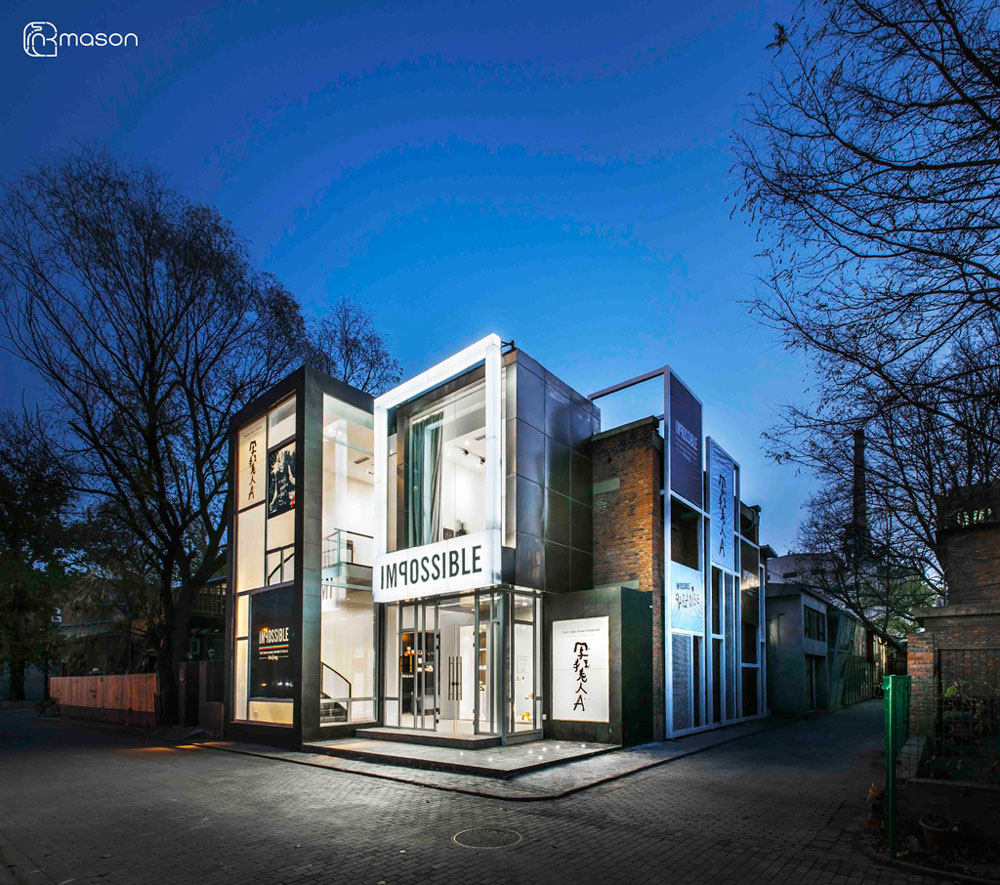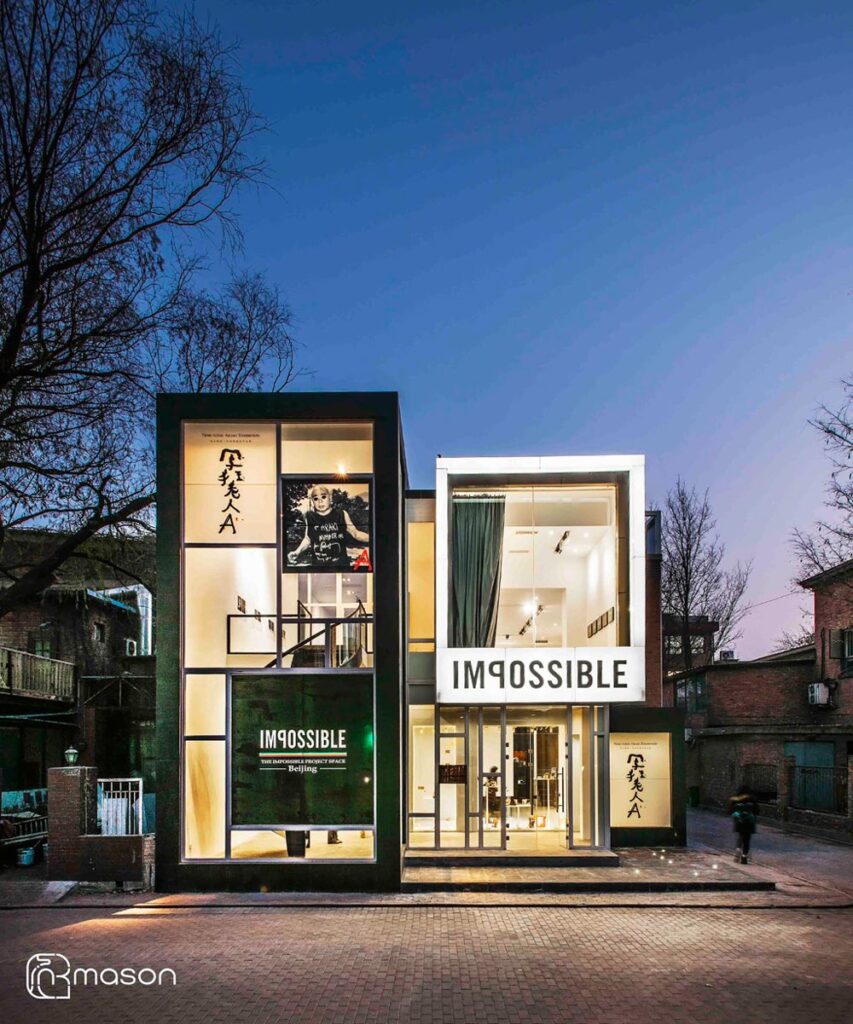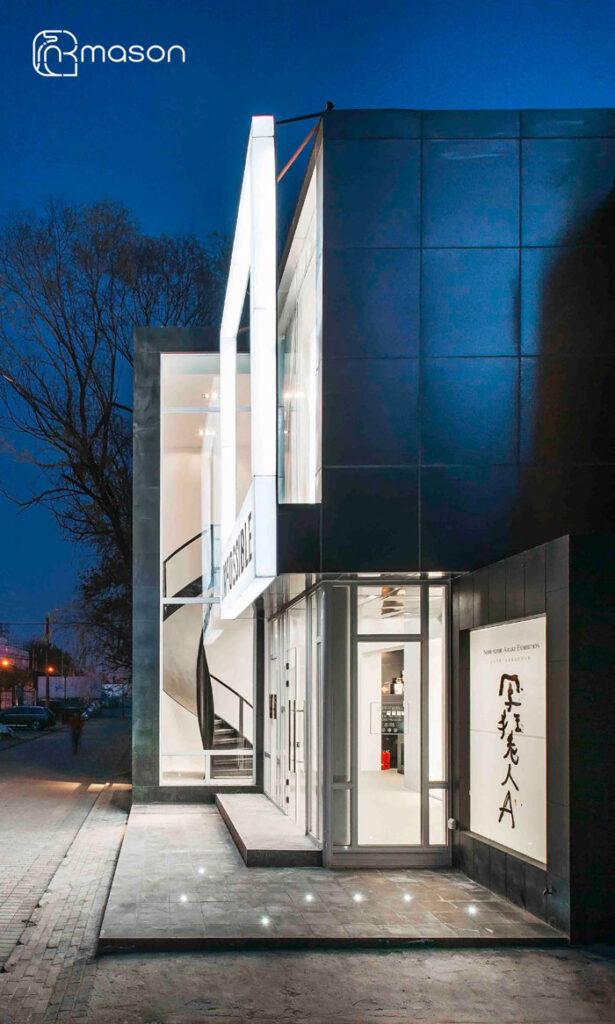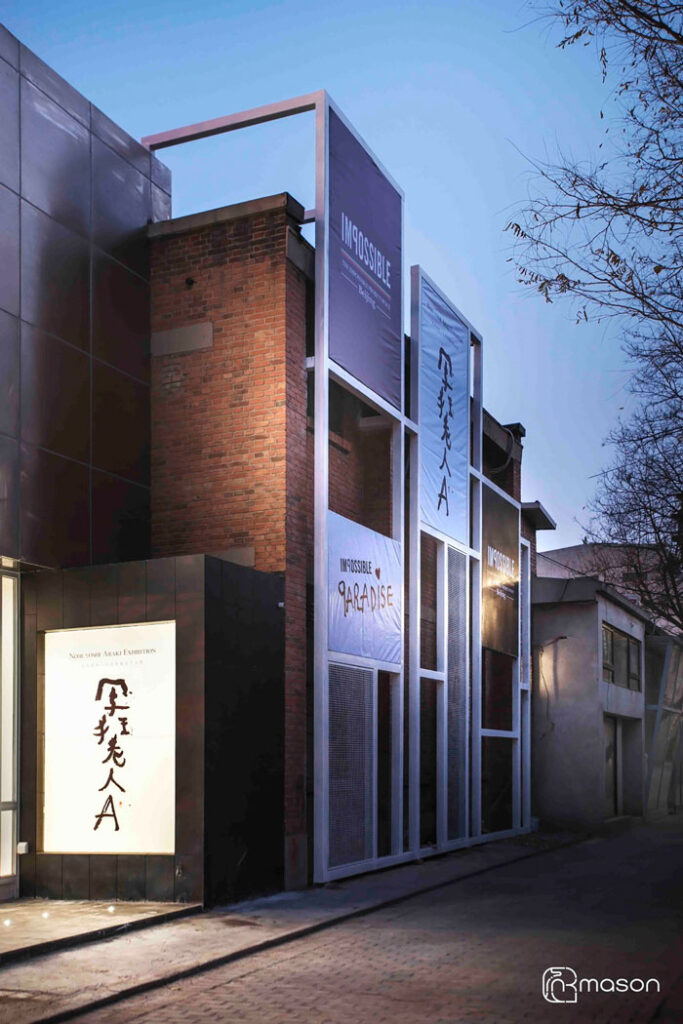Background
After more than two months extensive make-over to a decommissioned military factory building in Beijing 798 Art District, Inkmason was able to give a new life to this abandoned 2 stories old brick structure and transform it into a modern art gallery for Impossible Project–the young and courageous brand redefining instant analogue photography.
经过两个多月的努力,Inkmason赋予了一座废旧厂房新的生命。它位于北京798艺术区,原本仅是一座2层旧砖结构的军事厂房遗址,但经过整体的改建,工厂变成了一座充满了青春气息的艺术画廊,成为了一座摄影艺术领域的先驱者——Impossible Project。

In 2008 at the closing event of the last Polaroid production plant in Enschede of The Netherlands, Florian ‘Doc’ Kaps, an instant photography enthusiast from Vienna, and the soon-to-be-former Polaroid production manager André Bosman decided to take action to save analog instant photography from pending extinction.
2008年荷兰恩斯赫德举办的宝丽来相机最后一次生产的发布会中,来自维也纳的瞬间摄影爱好者–Florian ‘Doc’ Kaps与前宝丽来相机生产厂经理–André Bosman一拍即合,决定采取行动保护即时模拟摄影这一技术。
With most of the original components of classic Polaroid film no longer available, a small team of engineers, chemists and instant film experts were established to start working on the dream of revolutionizing instant photography and bringing it into the 21st century. After two years of research, experimentation and development, Impossible introduced the world to the re-formulated instant analog film for classic Polaroid cameras. These films not only saved 200 million Polaroid instant cameras from becoming guttery useless, but also created a new movement in photography, attracting enthusiasts worldwide. Stories have been published in The New York Times, The Observer, Financial Times, Wired, Monocle, and Le Monde among others – proving that even in our digital age, the magic of analog instant photography is still alive and well. Instant photography lovers embraced these new materials as a platform for their creative work. It provides a new form of creative freedom allowing artists, and photographers to push artistic boundaries by raising instant analog photography to a new level.
由于原相纸的化学成分无法得到,于是由机械工程师、化学家和即时显影专家组成的团队,经过两年的努力,找到了相纸的化学成分并将它带入21世纪。当Impossible向世界重新展示了宝丽来相机的胶卷-即时显影胶片,2亿台宝丽来相机通过这种新的胶片技术得到了拯救,也重新唤起了人们对它的喜爱之情。并且这件传奇事件还被发布在《纽约时报》、《观察家报》、《金融时报》等众多媒体上,同时也证明了,即使在数字时代,即时显影摄影技术热度仍在。爱好者们通过新材料获得了更自由的创作空间,同时也将即时显影技术推到了一个新的高度。
The revolutionary vision and ambition of the brand reach far beyond the production of instant film. To support and promote this avantgarde art form, The Impossible Project Spaces were set up around the world as a vivid hub for artistic and photographic communities. Besides carrying all the available analog films and cameras, the Impossible Project Spaces also held a wide range of exhibitions, workshops and artistic projects on display.
Impossible的品牌革命性和雄心,使其将经营范畴推广到更宽广的舞台。为了推广这一前卫性的艺术形式,Impossible Space在世界各地设立展示空间。除了展出各种即时显影胶片和相机,它们还不定期举办各种艺术项目展览和研讨会。
In spring 2013, the company’s partner in China – Loone Community decided to set up a new Impossible Project Space in Beijing. This will eventually be the 6th Impossible Space worldwide, among Tokyo, Paris, New York, Russia, and Poland, putting Beijing on the map of analog photography.
2013年春天,Impossible在中国的合作伙伴–乐玩公社,决定在北京设立一个新的Impossible Space。这也是他们继在东京、巴黎、纽约、俄罗斯和波兰后,设立的第六个展示空间。
Inception
From the beginning, it was clear that the Impossible Project Space in Beijing should combine art gallery, product display, and retail function. The ideal location for such establishment would be in the renowned 798 Art district, which is a vibrant area, combining art galleries, creative industries, and retail shops.
在最初时,Impossible Project Spacein Beijing就有明确的空间功能要求。它要是一个结合了画廊、产品展示和零售功能等多需求为一体的空间。基于空间上面的要求,北京798艺术区就理所当然的成为最符合所有要求的地点。
Through wide search of design companies in Beijing, Ms. Nina Huo, Director of Loone Community and Impossible China found Inkmason and the architectural conceptual design service agreement was signed in July 2013. After 3 months the concept design was finalized and approved by Impossible. It is a total face-lift for the original 2 stories brick structure and yet preserving and integrating the original beauty and integrity of the masonry work. The total GFA increased from the original 167SQM to 276SQM with the extension both on the ground floor retail area and the second floor gallery space.
通过对北京设计公司的搜索,并且基于对Inkmason的多次了解后,The Impossible Project Space 就与Inkmason在2013年7月确认了合作关系。3个月后,概念设计完成并得到了认可:将2层的砖结构建筑通过维护和石材加工保留其原始面貌和建筑的完整性。而设计面积也从最初的167㎡扩展到了276㎡,包括了一层的零售区域和二层的画廊。
On 15 Nov 2013, The Impossible Project Space finally opened with great anticipation. The opening event was also the occasion to launch an exhibition of the famous Japanese artist Araki Nobuyoshi. Since its opening, the Impossible Project Space held countless exhibitions and events of influential international and Chinese artists. It becomes a new landmark in 798 with its location right at the northern edge of the district, and its prominent backlighted Impossible photo frame brightening up the rather dim artist community.
2013年11月15日,The Impossible Project Space开业仪式如期而至。开幕活动当天也借势推出了一个日本著名的艺术大师Araki Nobuyoshi的展览。Araki是日本当代摄影的创始人之一,影响了包含中国在内的无数摄影师。自开业以来,The Impossible Project Space举办的展览和开展的活动不计其数,而其影响力也越来越广泛。它已经成798北区的新地标,而其突出的发光相纸框也照亮了昏暗的艺术区。
The Photo Frame
The design for Impossible Project Space represents the brand and how it revitalizes the art of instant analogue photography. Renovating an abandoned brick house and bring it up-to-date with an elevated purpose is in fact quite the same as the Impossible story – revitalizing a closing factory and transforming something “instant and convenient” into something artistic.
Impossible Project Space的建筑设计展示了它的品牌内涵:如何将即时显影技术重新获得大众喜爱。事实上,改造一间废弃的砖房,并把它赋予时代的气息这就如同ImpossibleProject 企业发展的故事一样–拯救即将关闭的工厂,将产品赋予“即时和方便”的功效并与艺术设计相结合。Inkmason的设计团队想要通过保留建筑的原始砖结构,从而强调建筑的历史意义。所以,新的设计应该是与老砖瓦结构和谐共存,而不是为了新设计而去破坏原有建筑所具有的内涵,设计应该是通过外在的素材将原有的建筑更新,而不是去破坏。最后的解决方案是通过将新旧材料的碰撞与结合:建筑外墙上,各种新旧材料以层次并列的方式加上不同透明度的材料,使人们不仅可以看到原本的砖结构,还可以欣赏到新旧材料的和谐结合,使建筑物焕然一新。
The new structure extends outward to gain more exposure to the northern defused daylight. From the outside, the whole building facade is divided into several “boxes” – a brick box being the original structure, a tall black box being the new vertical circulation to the gallery on the second floor, the metal box being the vestibule with the Impossible photo frame facing the northern boundary road of the art district, and finally the glass box underneath the metal box, signifying the entrance to the Space. Inside the vertical black box there is a new spiral staircase that leads the visitors to the second floor gallery.
建筑的前面原本拥有一个院子,但在新的设计中利用了这一空间。不仅增加了室内面积,同时也提高了室内的采光。从外面看,整个建筑由几个“盒子”嵌套而成,“砖盒子”是原本的砖结构墙体。二层高的“黑盒子”,是螺旋楼梯,可以直接进入二层的展厅。“金属盒”相当于相框,人们站在这里可以俯瞰艺术区北侧。“金属盒子”的下方是“玻璃盒子”,作为进入Impossible的入口。“玻璃盒子”的旁边又有一个小的“黑盒子”,是宝丽来相机的展示橱窗。
During different time of the day, the different “boxes” reflect and react with the sunlight differently, creating an ever-changing play of architectonic shapes and forms. The stainless steel panels reflect the surrounding, while the black slates panels absorb lights and emit warm or cold ambiance at different hours. The building itself becomes an apparatus capturing instantly its context at every single moment, just like what the Impossible product. Some say that architecture has to withstand the test of time, for Impossible Project Space Beijing, time is captured and becomes part of the architecture.
在一天中的不同时间,不同材料的外观对阳光的反射也不同。根据天气或季节的不同,建筑物在每一个时刻捕捉到的瞬间景象也都有所不同,而这也就像The Impossible Project的产品一样。有人说,建筑是要经得住时间的考验,对于The Impossible Project SpaceBeijing 来说,时间已经被捕捉,并且成为了整个建筑的一部分。

“It is truly an amazing experience witnessing the old brick building transforming into the new gallery, home for the Impossible Project Beijing. We cannot image how the founder of the Impossible Project Brand feels when they re-created the first Impossible film from an abandoned factory in the Netherland. I am sure it would have brought tears of joy.” – Kin the director of Inkmason.
能亲自见证这个两层高的老楼转变成这现代感强烈的Impossible Project Space,我们觉得非常感动, 我很难想像当ImpossibleProject的创始人从接手废弃工厂到拿到他们重新研发的相纸时会有多感动。-Kin,Inkmason设计总监。


